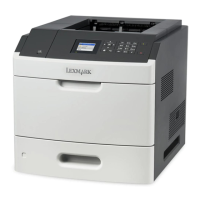Deviations
166
The LXK BCC also performs the exact same way as the HP BDP.
The BCE does not support lowercase “a–z” start and stop character input, does not translate to
uppercase, and will throw a “Error 12—Invalid Character” error. The BCE is operating per the specs
noted above, and does not translate lowercase to uppercase.
Therefore, the Forms and Bar Code Card firmware must convert any Codabar lowercase start-stop
input to uppercase before submission to the BCE. This will then generate the proper uppercase start
and stop bar code characters. However, visually the HRT start and stop characters will also be
uppercase, reflecting the actual data within the bar code itself.
Maximum encodable character length
The BCE allocates memory for a requested bar code on a per-symbology basis. It does not allocate
memory on a symbol-by-symbol basis as it builds the bar code, but rather allocates the entire
memory block needed at once for each bar code it generates. It uses this technique to reduce the
overhead of memory allocation, and ensure good performance.
The LXK BCC allocates memory in a different manner, and how HP allocates memory is unknown.
Because the BCE allocates a finite amount of memory per bar code, input data with large amounts of
encodable data will fail, usually with a garbled bar code image that does not have well-formed bars
and spaces, or in some cases a code 19 NotEnoughMemory.
The practical commercially viable limit for a typical one-dimensional bar code is approximately 20–25
characters. Large bar codes may not fit on the page, or the reliability of the scan may begin to suffer
with large amounts of encoding data. However, the BCE will still attempt to encode large amounts of
input data, until the image fails. There is no warning or error associated with excessive data that
leads to garbled images.
The maximum amount of input data is shown in the table below. This table is just a guide, not an
absolute definition of capability, and could change upward or downward depending on the following
assumptions:
• Amount of RAM in the printer
• Version of BCE
• Compiler/linker used
• Other unknown factors

